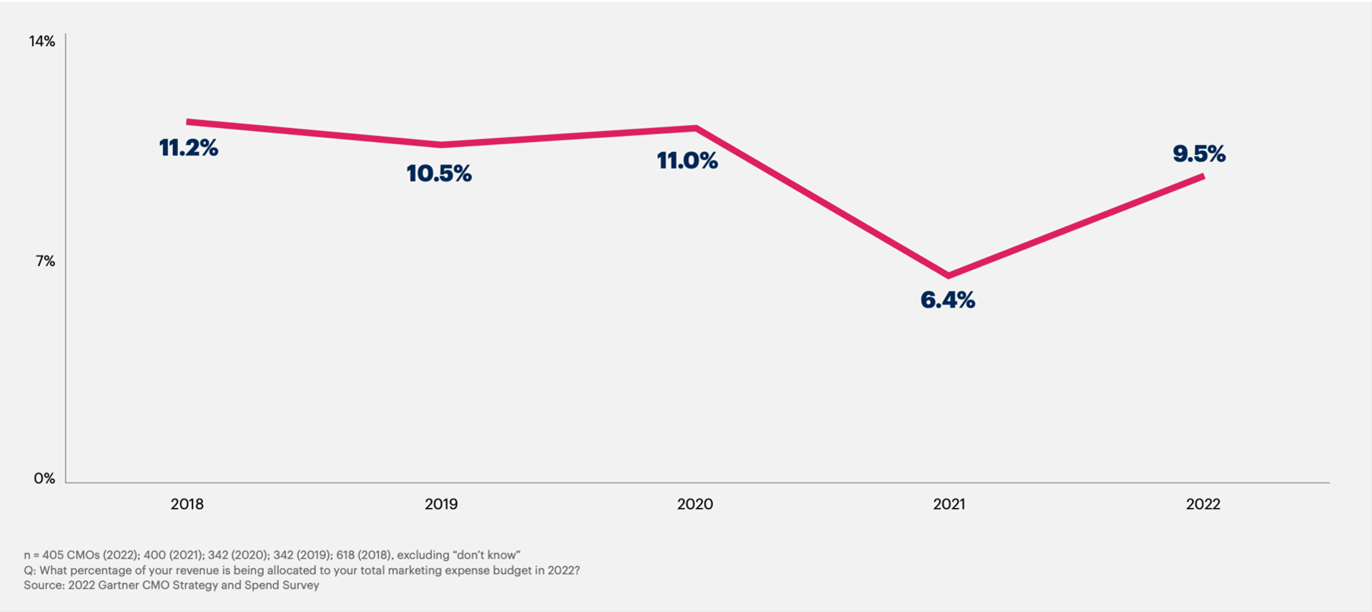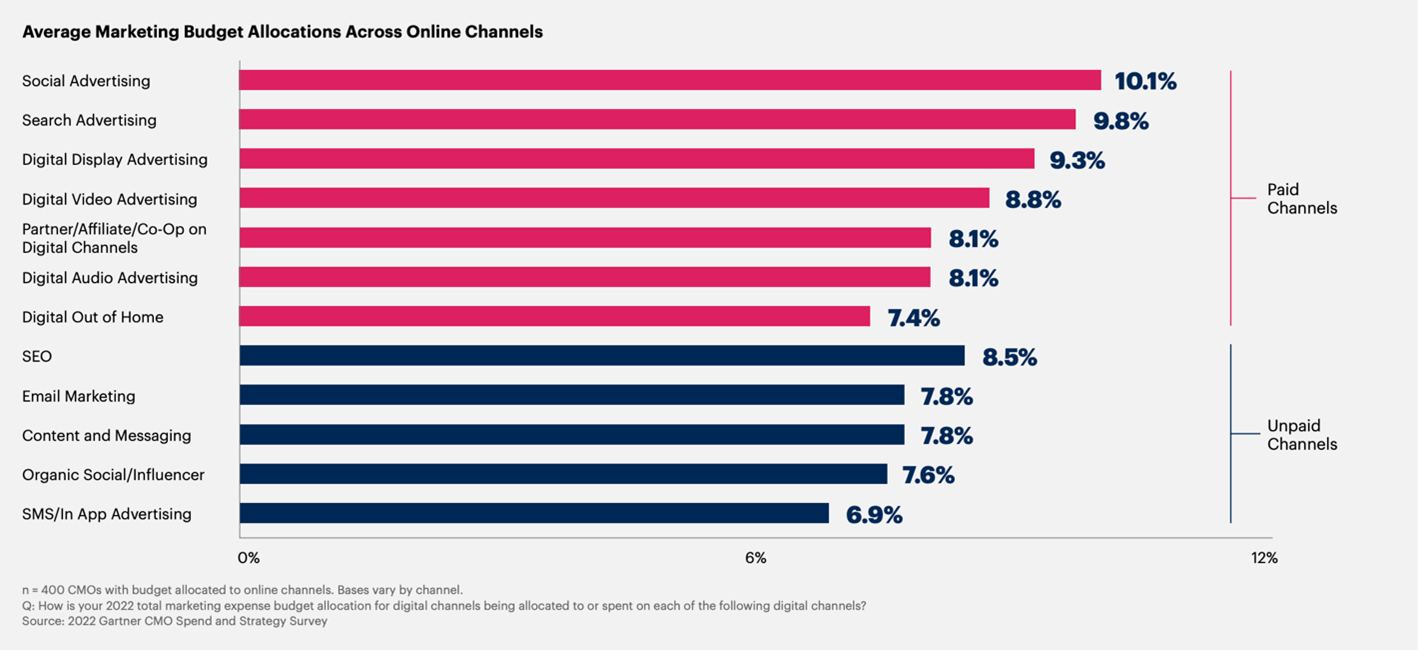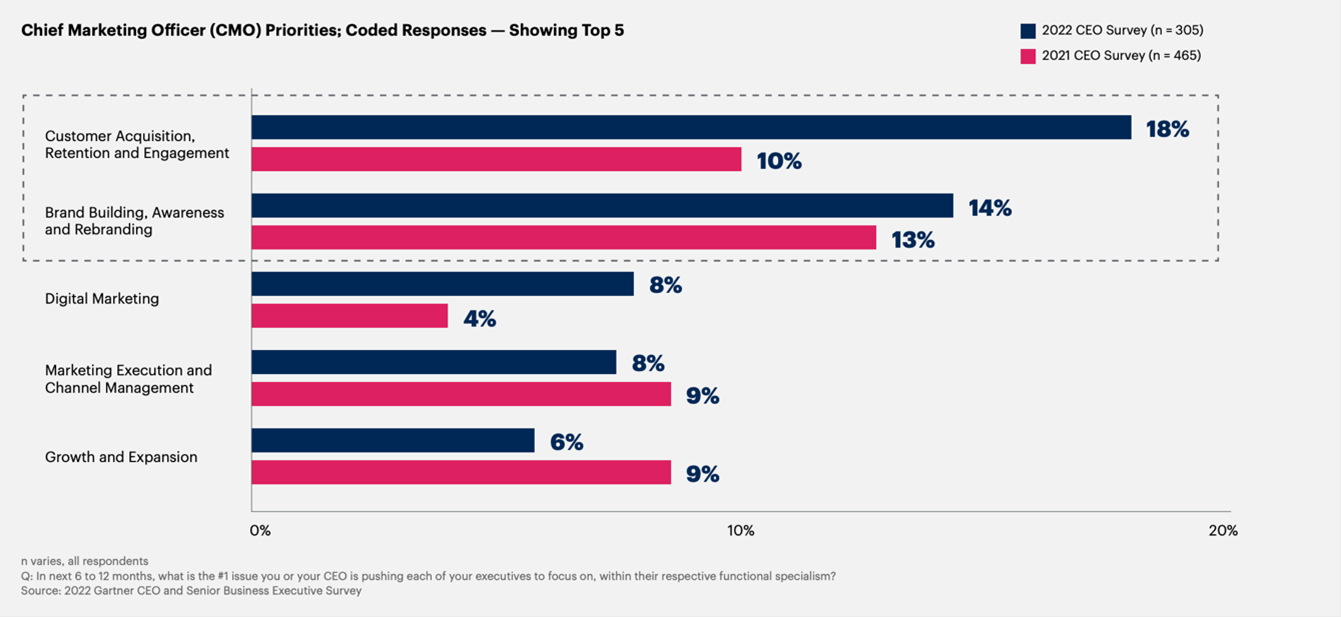7 essential insights to help you determine your marketing budget for 2024
In the ever-changing world of marketing, it can be challenging for CMOs to determine the correct marketing budget. The economic landscape and technological advances in the marketing industry calls for a new approach to budgeting.
In this article, Jacob Eeckhout, marketing lead at iO, shares seven marketing budget insights, with recommendations for how to determine your budget for 2024.
1. Historical perspective
Between 2018 and 2022 marketing budgets averaged 10.9% of company revenue. This percentage dropped significantly to 6.4% in 2021. In 2022, the percentage rose again to 9.5%.

Our recommendation is to allocate a marketing budget of 10% of the company's turnover for 2024. This takes into account falling inflation on the one hand, and challenges such as (the impact of) the war in Ukraine on the other.
2. Sector-specific budget insights:
Different business sectors use different benchmarks for the allocation of marketing budgets. As a result, companies' marketing budgets can vary significantly across industries.
In 2022, the financial sector topped the list of marketing budget percentages. This with an average budget percentage of 10.4% of the company's turnover.
As recently as 2022, the technology sector, which was hit hard by the pandemic, experienced a resurgence. Here, the average budget percentage increased from 5% in 2021 to 10.1% in 2022.
The consumer goods sector, which topped the list in 2021, lost some places in 2022. Here, the average budget rate dropped to 8.0%, mainly due to the impact of inflation.
Do you want to compare your marketing budget with your sector’s standards? Then, for example, studies such as Gartner's CMO Spend and Strategy Survey or Deloitte's CMO survey are a reliable source.
Would you like support or guidance with determining your marketing budget? iO has expertise in more than 20 sectors and is here to help you.
3. The hybrid marketing model
The shift from a pure digital first approach to a hybrid model demonstrates the importance of balancing online and offline strategies.
Online channels accounted for 56% of the marketing budget spend in 2022. Offline channels, while slightly lower in budget allocation, highlighted the resurgence of traditional media in the marketing mix.
If you want to take a hybrid approach, allocate your budgets based on the evolution of your customer journeys, taking into account both online and offline channels. And don't forget to be flexible: adjust your budgets according to the performance and results of channels.

4. Prioritise digital channels
Social media and search ads assumed a dominant position in 2022 budget rounds. Platforms such as TikTok, Instagram, Facebook, Google continue to offer lucrative opportunities for marketers.
In order not to miss out on these opportunities, you should allocate a significant portion of your digital budget to both established and emerging social platforms. You want to avoid dependence on one (established) channel. A balance is necessary.
The 70/20/10 rule is a useful guide to social marketing:
- Invest 70% of your marketing budget in established channels with proven ROI.
- Invest 20% in emerging channels with broad adoption by your target audience where the ROI may not yet be fully proven.
- Invest 10% of your budget in new platforms (so-called 'moonshots') where competitors are not yet present.
Unsure which established channels will perform best for you? Our data modelling solutions give you access to useful insights from your data so that you can see which channels are your top performers.
5. Offline Channels
The pandemic was almost a death knell for offline channels such as trade shows, events, and sponsorships. But now those channels are making a comeback. B2B industries are investing significantly in events, while B2C continues to focus on media such as television.
So, it is worthwhile considering offline channels as an essential part of your marketing mix. These channels are indispensable for brand building and maintaining customer loyalty, especially in a world that is driven by physical interactions.
To get the most out of your marketing budget, it is essential to continuously monitor which channels and campaigns generate the most revenue and then shift your budgets from channels that underperform to channels that do well.
6. Capacity shortages
It is crucial to understand and address the capacity gaps within marketing teams. For example, 58% of CMOs felt their teams didn't have the capabilities to execute their strategies effectively in 2022.
That is why, as a CMO, it is smart to redirect some of your marketing budget towards:
Devoting some of your marketing budget to the above-mentioned things is a smart investment.
7. Budget allocation considerations
Aim for a balanced approach. The 50.1% of the marketing budget spent on brand awareness seems to be in balance with the 49.8% that goes to performance media. But CMOs also need to consider market dynamics and specific brand goals.

Tactical budget allocation for B2B in EMEA:
- Lead generation: 38%
- Brand awareness: 26%
- Demand generation: 20%
- Account-based marketing 16%
Now that the end of third-party cookies is imminent, the need to shift the strategic focus to first-party data is more urgent.
According to a study by Deloitte, CMOs expect to use first-party data (75%) compared to second-party (46%) and third-party (39%) in the next two years.
Do you want to know what the impact of the cookieless future will be on your company? Then use our cookieless calculator. You will receive an estimate of the potential loss of sales and website visitors, as well as tailor-made advice to limit the impact of the loss of third party cookie data.
Conclusion
Determining the ideal marketing budget for 2024 requires a holistic view that combines past insights with trends and forward-looking strategies.
As the marketing world continues to evolve, the golden rule remains focus on authentic customer engagement to deliver measurable ROI.
Whether it's digital dominance, offline engagement, or a combination of both, with the right budget decisions, you'll be on the road to marketing success.
How can we help you?
Contact us if you need help determining your plans and/or budgets for next year. Our marketing specialists will help you find your way.
|
Checklist: 15 tips to make your marketing and digitisation budget for 2024 smarter
Now that you have a better idea of which benchmarks are the norm in terms of marketing budgets, and budget distributions, it's time to roll up your sleeves and get to work. We are here to help you with that too. Download our checklist with "15 tips to make your marketing and digitisation budget for 2024 smarter". This checklist with an inventory of cost items and templates that you can use, you’ll be off to a flying start.
Download the checklist
|
Sources:
https://cmosurvey.org/wp-content/uploads/2020/02/The_CMO_Survey-Results_by_Firm_and_Industry_Characteristics-Feb-2020.pdf
https://www2.deloitte.com/us/en/pages/chief-marketing-officer/topics/marketing.html
https://cmosurvey.org/wp-content/uploads/2022/02/The_CMO_Survey-Topline_Report-February_2022.pdf
https://business.linkedin.com/content/dam/me/business/en-us/amp/marketing-solutions/images/lms-state-of-b2b-marketing/pdf/the-b2b-benchmark-report-2023-final.pdf
https://emtemp.gcom.cloud/ngw/globalassets/en/marketing/documents/marketing_budgets_2022_research.pdf
https://blog.hubspot.com/marketing/marketing-budget-percentage